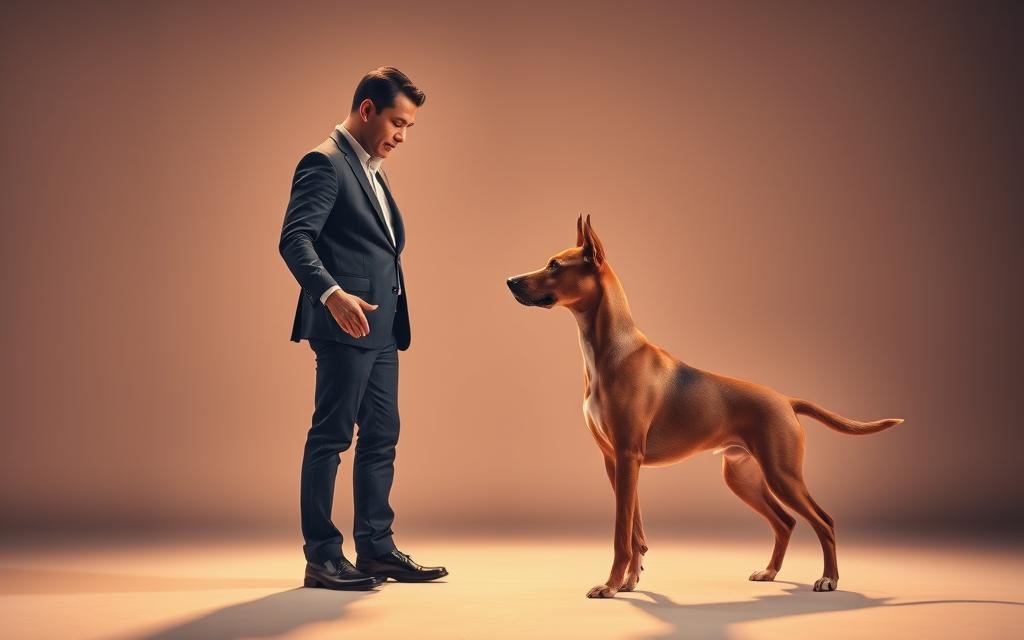Did you know about 60% of dog owners think their pets can learn complex tricks? This shows a growing belief that advanced dog training is for all dogs, not just competition ones. By exploring advanced training, we can unlock our dogs’ full abilities.
This makes them better companions and great performers in activities like agility and dog trick training. It also strengthens our bond and makes our dogs happier. Let’s take our pups to new heights!
Key Takeaways
- Advanced dog training enhances skills beyond basic obedience.
- Training methods include agility training for dogs, scent work, and behavioral shaping.
- Strong bonds are formed through consistent, engaging training experiences.
- Complex tricks can provide mental stimulation for your dog.
- Investing in advanced training leads to a happier and more well-rounded pup.
What is Advanced Dog Training?
Advanced dog training is more than just basic commands. It includes agility courses, complex tricks, and specialized tasks. These activities challenge a dog’s mind and body. It’s about understanding dog training techniques to improve your pup’s skills.
Many dog owners choose professional dog training for the right guidance. This ensures they can help their dogs reach new heights.
Understanding the Basics
This training builds on what dogs learn early on. It helps them perform commands with precision and engage in activities that boost their intelligence. The goal is to make training fun, not just a chore.
Why It Matters for Your Dog
Advanced dog training offers many benefits. It improves a dog’s focus, enhances their behavior, and builds confidence. Without it, dogs might get bored and exhibit bad behavior.
By training them well, dogs can handle real-world situations better. They learn to control their impulses and obey commands more effectively.
Benefits of Advanced Dog Training
Advanced dog training opens a world of possibilities for dogs and their owners. It’s more than just learning commands. Each part of training makes our bond with our pets stronger.
Improved Behavior
Advanced dog training greatly improves a dog’s behavior. Dogs get mental stimulation from challenging exercises. This helps stop bad habits like barking, digging, and chewing.
As dogs learn to follow commands better, owners feel more at ease. This leads to safer times in public and at home.
Enhanced Bonding Experience
Training sessions offer a special chance to bond with pets. Overcoming challenges together builds trust and understanding. Learning new skills together brings joy and strengthens the bond.
This shared success creates a deeper connection. It also makes memories that last forever.
When to Start Advanced Training
Deciding when to start advanced dog training is key. It depends on your dog’s age and if they’re ready. Knowing these helps you and your dog enjoy the training journey.
Age Considerations
Dogs can start advanced training around six months old. They should know basic commands first. But, younger dogs can do special classes that match their growth stage.
Choosing the right activities helps them grow and stay confident. It keeps them from getting frustrated.
Signs Your Dog is Ready
Before starting advanced training, check if your dog is ready. Look for these signs:
- Mastery of basic commands like sit, stay, and come
- Eagerness to learn and join in training
- Showing enthusiasm and wanting to work with you
Seeing these signs means your training will be fun and effective. It will also make your bond stronger.
| Age Range | Considerations |
|---|---|
| 6-12 months | Ideal for starting advanced dog training while ensuring they have learned basic commands. |
| 3-6 months | Look for specialized classes that challenge young minds without overwhelming them. |
| Over 1 year | Focus on skills enrichment and advanced commands; reassess basic skills to ensure solid foundations. |
Different Training Methods
Exploring various training methods for dogs can greatly improve your pup’s skills. Each method has its own benefits, making training more effective. It’s important to find the right method for your dog’s learning style.
Clicker Training
Clicker training uses a small device that makes a sound when your dog does something good. It gives them instant feedback, helping them learn quickly. I’ve seen how well it works for teaching complex skills.
The sound is clear, making it easy for dogs to connect with the action. This leads to faster learning.
Positive Reinforcement
Positive reinforcement rewards your dog with treats, praise, or playtime for good behavior. It boosts motivation and strengthens your bond. Consistent use of this method reduces behavioral issues.
Every moment becomes a chance to learn and grow. For more on positive reinforcement, check out this stylish and durable dog collars page.
Leash Training Techniques
Good leash training keeps your dog safe and in control during walks or agility exercises. The right leash and harness make a big difference. It’s essential for future training.
| Training Method | Key Features | Benefits |
|---|---|---|
| Clicker Training | Immediate feedback, sound marker | Quick learning of complex skills |
| Positive Reinforcement | Rewards include treats or praise | Improved behavior and stronger bond |
| Leash Training | Variety of leashes and harnesses | Control and safety during exercises |
Popular Advanced Training Commands
Exploring advanced dog commands opens up a world of possibilities. It enhances your dog’s skills and bond. Dog recall training is key for safety and reliability in various environments. Let’s look at some popular advanced training commands, including recall, complex tricks, and obstacle course navigation.
Recall and Distance Commands
Teaching recall and distance commands is vital. It ensures your dog responds promptly, even from afar. Effective dog recall training needs consistent practice and rewards.
Start by using a long leash in a quiet area. Gradually increase the distance as your pup becomes more confident. It’s essential to practice in environments with distractions. This builds your dog’s reliability in responding to commands under varying conditions.
Complex Tricks
Complex dog tricks are fun and stimulating. They entertain and deepen the bond between you and your pet. Start with one trick at a time and use positive reinforcement.
Celebrate small victories to keep training enjoyable and engaging. This keeps your dog motivated and excited.
Obstacle Course Navigation
Agility and obstacle course navigation is exciting. It enhances physical fitness and coordination. It also fosters focus and discipline.
To get started, introduce simple obstacles gradually. Use encouragement and treats to motivate your dog. Ensure they enjoy the experience.
As your pup masters the basics, increase the complexity of the course. This keeps the training exciting and challenging.
Incorporating Training into Daily Life
Adding training to our daily routines can really boost a dog’s skills. It also makes learning fun for both of us. Short, fun training sessions keep my pup excited and eager to learn.
It’s easy to mix training into our daily activities. Whether we’re walking or playing fetch, every moment is a chance to practice. This approach helps my dog learn faster and behave better.
Short and Engaging Sessions
I try to keep training sessions short, around 5 to 10 minutes. Using games and rewards keeps my dog interested and motivated. This makes daily training a positive experience for them.
Routine Integration Strategies
Integrating training into our daily routines works well. I often use commands like “sit” or “stay” during walks or meal prep. This reinforces learning and encourages good behavior.
Choosing the Right Trainer
Finding the right dog trainer is key to your pet’s development and behavior. The world of dog training can be tricky, with no strict rules. When picking a trainer, I look at their methods, background, and teaching style.
Credentials and Experience
Checking a trainer’s credentials is vital. Certifications from groups like APDT or CCPDT show they know their stuff. A seasoned trainer knows dogs and how they learn, blending knowledge with care.
Client Testimonials
Reading what others say about trainers is insightful. Good reviews show a trainer’s success and connection with dogs and families. This feedback helps me trust my choice. Research and personal tips are key in making a decision.
In short, picking the right trainer takes careful thought and research. Looking at credentials and testimonials helps make a smart choice, leading to a great training experience.
For more on choosing a dog trainer, visit the AKC website.
Tools and Equipment for Training
Advanced dog training needs the right tools and equipment for success. You’ll need training collars, leashes, and interactive dog toys. The right gear makes a big difference in training.
Training Collars and Leashes
Good dog training tools include well-fitted harnesses and sturdy leashes. They offer control and comfort, helping your dog learn better. Choose equipment that fits your dog’s size and personality.
A sturdy leash gives firmness, while a comfortable harness keeps your dog secure. This makes training sessions better for both of you.
Toys That Encourage Learning
Interactive dog toys can make training more fun. Puzzle toys and treat dispensers reward your dog and keep them interested. These toys are great for learning, making training enjoyable for everyone.
Setting Goals for Training
Setting clear goals for dog training is key to success. I use both short-term and long-term goals to stay motivated. Short-term goals give me quick wins, while long-term goals guide my bigger vision.
Short-Term vs Long-Term Goals
Short-term goals keep me motivated and let me celebrate fast. They make training fun and boost my confidence and my dog’s. Long-term goals, though, give me direction and purpose, showing me where I’m headed.
Tracking Progress
Tracking my dog’s training progress is vital. I use journals or apps to keep track. These tools help me see what’s working and what needs work.
Overcoming Common Challenges
Dealing with dog training challenges can be tough. Every dog is different, and I face many obstacles in training. To improve, I use specific strategies that help me and my dog stay engaged.
Dealing with Distractions
Distractions are a big challenge. I start training in quiet places. Then, I slowly introduce my dog to new environments. This helps them stay focused.
Being patient and repeating commands is key. It helps my dog learn despite distractions.
Managing Frustration
Frustration happens to both me and my dog during training. I aim to keep our sessions positive. This means avoiding things that make my dog anxious.
It’s important to take breaks. This helps us both stay focused. Using calming techniques makes our training fun and enjoyable.
Continuing Education for Dogs
As a dog owner, I think learning should never stop. Continuing education is key for my pet’s growth and our bond. Advanced training classes let my dog learn new things and make friends with other dogs.
Advanced Classes and Workshops
Specialized workshops, like agility training or scent detection, are exciting for my dog. These classes are great for learning and socializing. My dog becomes more confident and loves to learn.
Online Training Resources
Online dog training is also a big help. It fits into our busy lives easily. Learning from home means my dog keeps growing and learning new things.





















